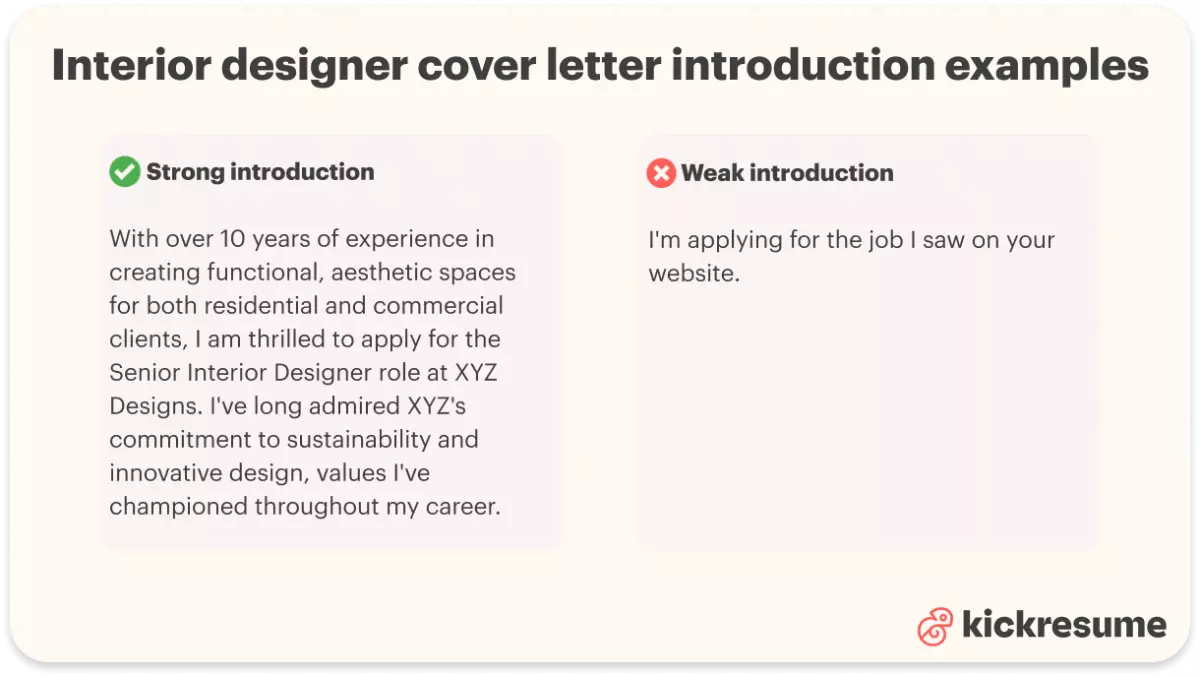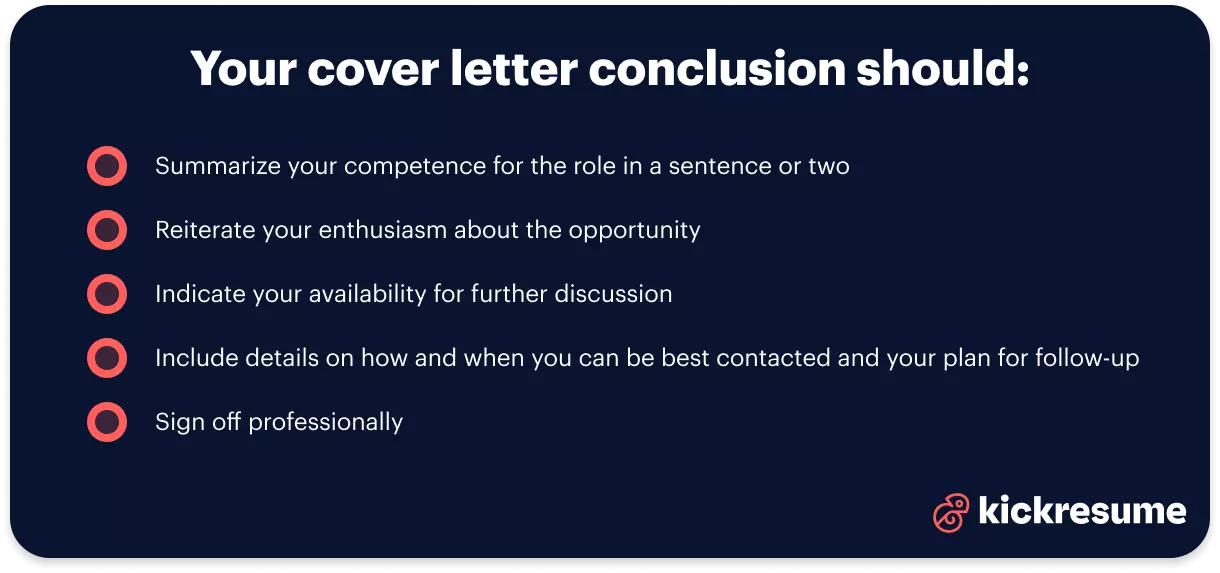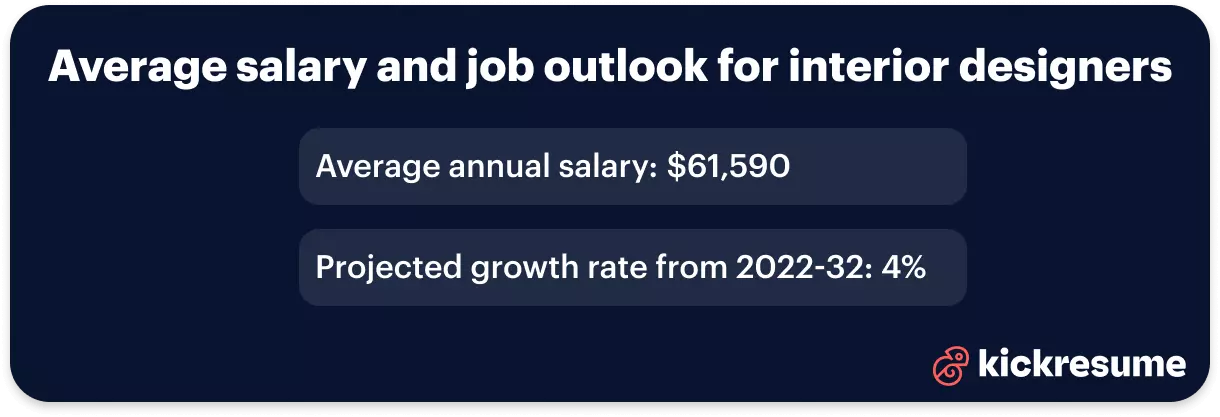Unleashing your creativity on an interior designer cover letter can be as fascinating as designing a space. But it's not just about colors and textures, it's about crafting a story that connects and resonates.
So, strap yourself in, move away those scatter cushions, and let's dive into the fine art of building a cover letter that's both noteworthy and visually compelling. Remember, it's about making an 'entrance,' pun absolutely intended.
Format Your Cover Letter Properly
Just like arranging elements in a room, formatting your cover letter requires intent and attention to detail. A well-structured cover letter ensures a smooth flow from beginning to end.
- Keep it concise: Aim for a single page. This isn't War and Peace; it's your career summary and an opportunity to showcase your ability to articulate succinctly.
- Clear structure: Like a well-designed room, your cover letter should have distinguishable sections. Include a captivating introduction, a powerful main body that includes your skills and achievements, and an intriguing conclusion.
- Use a professional font: Stick with easy-to-read fonts such as Arial, Times New Roman, or Calibri.
- Margins and spacing: Keep your margins around 1" and ensure there's sufficient white space. Avoid cramming text and make sure your paragraphs are neatly separated for easy reading.
- Bullet points: Use them to break down your skills or achievements. It adds visual interest and aids readability.
- Align text to the left: A simple yet effective trick. It aids readability and ensures consistency throughout the document.
- Bold headers: Make sure each section has clear headers. It shows your reader where they are in your career story.
- Consistent style: If you choose to bold your job titles, do it throughout the letter. Inconsistencies in your formatting can be as jarring as mismatched furniture in a room.
- File format: If you're sending your cover letter digitally, a PDF is your best bet. It retains your carefully planned formatting across all devices, like a perfect floorplan.
- Include relevant design elements: As an interior designer, you're in a unique position to include tasteful design elements in your cover letter. Not only does this display your skills in a practical way, it can also make your cover letter stand out from the sea of plain text documents.
Intentional, thoughtful formatting shows recruiters that you’re neat and thorough — essential traits for an aspiring interior designer. If in doubt, remember: your cover letter is a reflection of your professional self, so make it count.
Craft an Attention-Grabbing Header
The header of your cover letter serves as a professional nod in the form of your necessary contact details. Think of it as your business card, tidily placed at the top of your letter, catching the recruiter's eye.
An appropriately crafted header should include:
- Your name
- Your address
- Your contact number
- Your email address
- Your LinkedIn profile or an online portfolio
- The date
- The recipient’s name
- The recipient’s title
- Company name
- Company address
Here's an example of what not to do:

Why is it weak? In this example, James has not included his phone number, potentially causing unnecessary delays. The lack of LinkedIn or portfolio links denies the hiring manager a chance to learn more about his professional persona. What’s more, the header doesn't contain any information about the recipient. This impersonal touch can hint at a lack of effort or dedication to the specific role.
Now, take a look at this revision:

Why does it work? This example features complete contact details including a LinkedIn profile for a comprehensive professional snapshot. The addition of the recipient's information personalizes the cover letter, showing that it's not a mass-produced document but has been crafted for a specific role and person.
By showing attention to detail and professional courtesy in your header, you set the tone for your entire cover letter. Trust us, the difference between a detailed header and a skimped one is like a room with proper lighting versus one lost in shadow. Let your credentials shine bright!
Craft a Compelling Headline
Your interior designer cover letter's headline is your moment to shine. It's a one-liner that sums up your professional experience and skills, aiming to pique the interest of the recruiter. The more compelling it is, the better your chances of making them want to read further.
Why does this headline fall short?

While it indicates the purpose of your letter, it's as appealing as a room with no windows — bland and offering nothing unique.
Now, let's look at a more persuasive headline:

Why does it work? Not only does this headline highlight your specialization, but it also brings to the forefront your experience and recognition. It offers the recruiter a much sharper, more concrete idea of who you are as a professional.
Crafting a compelling headline for your interior designer cover letter isn’t just about stating your job title. It's about creating a captivating snapshot of your specialization and career focus. It's your chance to paint a vibrant picture of your capabilities right at the onset of your cover letter.
Tailor the Greeting
Having a solid opening act plays a vital role in pumping up the audience for what's to come. In your cover letter, this opening act is your greeting. And a personalized one breathes life into your cover letter, just like a perfectly chosen centerpiece does in a living room.
Digging out the hiring manager's name is an effort worth making. It demonstrates your sincere interest and effort in applying for the job. So, where to find the name?
You can start by looking at the job posting, the company’s website, or even make a quick call to the company.
Now, let's talk about crafting that perfect, personalized greeting.
Why do these options work?
- These greetings are formal and respectful. They show you've performed your homework and are addressing someone specific in the company.
But what if you can't find the hiring manager’s name despite your best detective work? No worries. The general rule is to keep your greeting professional and neutral.
Why are these options okay?
- They may not be personalized, but they’re still professional and respectful. These should be your fallback options, used only when the hiring manager's name isn't available.
Dressing up your cover letter with a suitable greeting is crucial. It starts the conversation and emphasizes your effort to connect on a personal level. And as every designer knows, it's all about the details.
Craft a Compelling Opening
A powerful cover letter opening should give a brief overview of your professional and academic journey, articulate why you're applying for the specific position, and mention any mutual connections, if any.
Why is this opening uninspiring?

This opening is both ambiguous and lifeless. It fails to showcase anything meaningful about the candidate or show genuine interest in the role — akin to a bland, monochrome room.
Now, let's move onto better examples:

Why does it shine? This introduction conveys the applicant's experience and aligns their professional values with those of the potential employer. It's like a well-placed piece of art that complements the overall room design.
But what if you're fresh out of design school, with your newly printed degree still warm? Don't worry, you can still knock it out of the park. Let's look at an example:

Why does it stand out? Despite the lack of professional experience, this candidate shows their passion, highlights their relevant education, and directly relates their aspirations to the company's profile.
Remember, the first few lines set the tone. Make it a conversation starter, a mood setter, and most importantly, make it uniquely yours. It’s your story, so ensure you tell it in the most captivating way.
Highlight Your Skills and Accomplishments
The core part of your cover letter — the body — is where you show off your top skills and notable achievements. It’s vital here to stay clear, pointed, and relevant with the job offer in front of you.
In the body, use short paragraphs or bullet points for readability and ease of understanding. Begin by spotlighting your most substantial achievements and skills, and then dive into how these align with the job requirements.
Each skill you mention should be accompanied by evidence or scenarios where you've applied these capabilities successfully.
For experienced interior designers, showcasing your skills is straightforward:

Here, the candidate provides specific details about their past responsibility, their achievement (increased usable space), and the positive outcome (praise from the client and extended partnership). This solid example showcases their skills and experience in a concrete way.
However, if you're recent out of school with no professional experience, focus on relevant coursework, internships, or extracurricular activities:

Remember, the body of your cover letter is about showcasing how your unique blend of skills and experiences make you the best fit for the job. It's about making the recruiter believe that you're the missing piece in their company's jigsaw.
Write a Persuasive Conclusion
If the introduction of your cover letter is the handshake, the conclusion is your lasting impression. Ending your letter allows you one last chance to highlight your interest in the role, your eagerness to contribute to the company, and integrate your professional narrative.
A persuasive conclusion should:
- Reiterate your keen interest in the position
- Outline your availability for further discussions
- Indicate how and when you can be best reached
- Denote your plan for follow-up
- End with a polite, professional sign-off
Why is this conclusion weak?

This conclusion is simply vague, impersonal, and passive. There's no distinct call to action, and it doesn’t truly insist on the next step.
Why does this conclusion succeed?

This conclusion actively reaffirms interest in the position, provides clear contact information, outlines next steps, and ends with a professional sign-off, implying courtesy.
Remember, crafting a strong, compelling conclusion is your final opportunity to cement in the recruiter's mind why you'd be a great fit for the role. It’s that aftertaste that should linger, making them eager to learn more about you.
Avoid Common Mistakes
Drafting a stellar cover letter is a meticulous task. The risk of small details slipping through is very much real. However, by being aware of some common mistakes, you can drastically reduce the chance of a hiring manager tossing your application aside.
- Typos and grammatical errors: Rely on spell-check tools, but don't stop there. Carefully proofread your letter or have another person review it.
- Lack of specificity: Always tailor your cover letter for each application, speaking directly to the job's needs.
- Excessive length: Keep it focused, relevant, and under a page.
- Rehashing your resume: Your cover letter provides a more detailed context for your achievements and conveys your passion for the job.
- Unexpected tone: Your tone should be respectful and enthusiastic without drifting into informality or slang.
Spotting the traps and avoiding these common mistakes will ensure your cover letter presents you in the best possible light. And after all, even the most beautifully designed room can be ruined by a single misplaced element. In your cover letter, every detail matters.
Average Salary and Outlook for Interior Designers
Getting into the field of interior design can be both creatively and financially rewarding. According to the most recent data from the Bureau of Labor Statistics (BLS) in May 2022, the average yearly wage for interior designers was $61,590. However, remember, this can vary based on experience, specialization, and region.
As for the job outlook, sound those optimistic trumpets! Employment of interior designers is predicted to grow 4% from 2022 to 2032. This growth rate aligns with the average for all occupations, suggesting a stable and promising future in the field.
Moreover, roughly 9,000 job openings for interior designers are projected each year, on average, over the decade. This gives aspiring and established designers alike the motivation to keep creating beautiful, functional spaces.
Entering the dynamic world of interior design can open up a whole palette of opportunities. When equipped with the right tools (like a well-crafted cover letter), you can make your mark in this vibrant industry.
Valuable Resources for Interior Designers
Venturing into the job market as an interior designer can feel a bit like looking for the right fabric in a warehouse — there's a lot to sift through. To help you navigate, here are some resources you should consider:
- Networking: Events and trade shows dedicated to interior design can provide you an excellent networking platform.
- Professional associations: Become a member of organizations such as the American Society of Interior Designers (ASID) or the International Interior Design Association (IIDA).
- Online platforms: Showcase your portfolio and connect with potential employers on platforms like LinkedIn, Behance, and Dribbble.
- Job boards: Websites such as Indeed, Glassdoor, and SimplyHired can be helpful to get a sense of available job opportunities in your area.
- Education and training: Consider exploring interior design certifications, courses, and webinars to polish your skills and stay updated.
- Mentorship programs: Check if your alma mater offers mentorship programs or internships in the field.
- Freelance work: Sites like Upwork and Fiverr can serve as a launchpad to gain work experience and build your portfolio.
- Social media groups: Join groups on Facebook or LinkedIn that focus on interior design. These communities often share job listings and discuss industry trends.
Remember, persistence and continuous learning are key to expanding your opportunities in the interior design sector. Keep seeking, keep learning, and keep growing in your craft. It's all part of the design process.

















